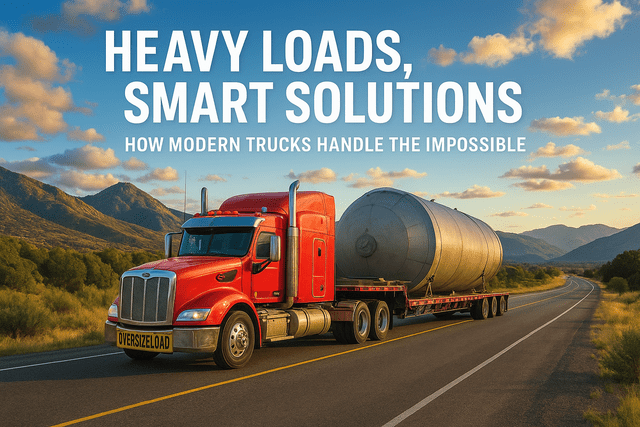
Heavy Loads, Smart Solutions: How Modern Trucks Handle the Impossible
You know those massive trucks you see on the highway carrying what looks impossible? The ones hauling entire houses, giant mining equipment, or enough concrete to build a small city? Ever wonder how they don’t just break down under all that weight? The answer is pretty amazing when you think about it.
Table of Content
The Science Behind Moving Mountains
Modern heavy-duty trucks are basically rolling computers that happen to have wheels. These machines can handle loads that would crush a regular car without breaking a sweat. The secret isn’t just having a bigger engine – though that helps – it’s about having systems that work together perfectly.
When a truck needs to haul 80 tons of cargo, everything changes. The transmission has to shift differently, the engine needs to work harder, and the brakes have to be ready for whatever comes next. But here’s the cool part: the truck actually figures out what it needs to do automatically.
Smart Transmissions Make All the Difference
The transmission in a heavy truck isn’t just a bunch of gears anymore. It’s got sensors everywhere, measuring things faster than you could blink. These sensors check how much weight the truck is carrying, how steep the road is, and even how the driver usually operates the vehicle.
When a truck starts climbing a hill with a massive load, the transmission doesn’t wait for the driver to tell it what to do. It already knows from the sensors that the truck is slowing down and needs more power. So it downshifts at exactly the right moment, keeping the engine in its sweet spot where it produces the most torque.
For drivers looking to understand more about these advanced systems, companies such as Heavy Automatics specialize in the technology that makes these heavy-duty operations possible. Their expertise shows how modern automation has transformed what trucks can accomplish.
Reading the Road Ahead
The smartest trucks today don’t just react to what’s happening right now – they actually predict what’s coming next. Using GPS data and road mapping, the transmission system can see that there’s a steep downgrade coming up in two miles. It starts preparing for that hill before the driver even sees it.
This means the truck can shift to the right gear early, use engine braking more effectively, and save the regular brakes for when they’re really needed. It’s particularly important when hauling heavy loads because stopping 80 tons takes a lot more planning than stopping your family car.
Handling Extreme Conditions
Heavy trucks often work in places where regular vehicles would get stuck before they even started. Construction sites, mining operations, and remote industrial areas all present unique challenges. The trucks that work in these environments need transmission systems that can handle stop-and-go traffic in thick mud, steep grades with loose gravel, and constant heavy acceleration.
Modern automatic transmissions adjust their shift patterns based on these conditions. If the truck detects that it’s operating on a slippery surface, it changes how aggressively it shifts to prevent wheel spin. In dusty conditions, the system monitors temperatures more carefully to prevent overheating.
The Human Element
Even with all this technology, the driver still plays a huge role in how well these systems work. The best heavy-duty transmissions actually learn from how each driver operates. Some drivers are more aggressive with acceleration, while others prefer a smoother approach. The transmission adapts to these patterns over time.
This learning process means that a truck becomes more efficient the longer one person drives it. The system builds a profile of driving habits and optimizes its responses accordingly. It’s pretty remarkable when you think about a machine that gets to know its operator personally.
Fuel Efficiency Under Pressure
You might think that hauling heavy loads automatically means burning tons of fuel, but modern trucks are surprisingly efficient. The transmission plays a big part in this by keeping the engine operating at its most efficient RPM range whenever possible.
When the system knows a load is particularly heavy, it adjusts the shift points to keep the engine from working harder than necessary. This means the truck can maintain highway speeds while using less fuel than older models that relied purely on mechanical systems.
Reliability When It Counts
The most impressive thing about these modern systems isn’t just what they can do – it’s how reliably they do it. Heavy trucks often operate 24 hours a day in harsh conditions, and transmission failure isn’t an option when you’re hauling critical cargo.
These systems are built with multiple backup sensors and fail-safes. If one component stops working properly, the system can usually detect the problem and adjust its operation to compensate until repairs can be made.
What This Means for the Future
The technology in heavy-duty transmissions keeps advancing rapidly. Future systems will likely be even better at predicting road conditions, communicating with other vehicles, and optimizing performance in real-time.
Connected truck networks are already being tested, where trucks can share information about road conditions, traffic patterns, and optimal routes. Imagine a convoy of heavy trucks automatically coordinating their transmissions to maintain perfect spacing and fuel efficiency on long hauls.
Electric and hybrid heavy vehicles are also changing the game. These trucks use different power delivery systems, but they still need intelligent transmission management to handle massive loads effectively. The principles remain the same – it’s all about matching power delivery to the demands of the moment.
Why This Actually Matters
Think about it – trucks today can haul stuff that would have been totally impossible twenty years ago. You’ve got mining equipment that weighs as much as a small building getting moved across states, and construction materials heading to job sites in the middle of nowhere. These trucks just handle it without any drama.
The next time you’re stuck behind one of these massive rigs on the highway, there’s actually something pretty cool happening inside. That truck has a computer brain that’s constantly figuring out the best way to keep moving. It’s checking the weight, watching the road, and adjusting everything faster than the driver could ever do manually.
Pretty wild when you think about how much technology goes into something that most people just see as a big truck blocking traffic. These machines have gotten really good at doing jobs that seemed crazy difficult not too long ago.


